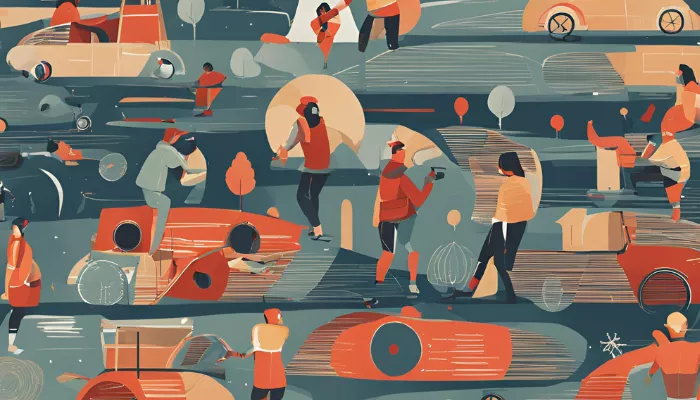Why Leadership Training Fails And What To Do About It
One of our Rainmakers training clients approached us recently and told me that they’ve invested a lot of money in previous training but have never seen its effectiveness on their employees.
It’s a sad reality I’ve seen in many companies. Yet, many continue doing leadership training, whether in-house or outsourced, without evaluating if the exact training impacts results.
In this post, we’ll examine why leadership training fails and what to do about it (and what you should avoid) so you can maximize the training investment.
Common Reasons Leadership Training Fails
1. Lack of Clear Objectives
Many training programs, including topics on leadership and management, start without clear objectives. As common sense as it sounds, HR teams hire outsourced training providers without first understanding their employees' needs.
They would consider hiring a leadership trainer, but the reality is that the root cause analysis of their needs went beyond just leadership—examples would be a lack of performance management systems or conflicts rampant among team members that can’t be easily solved by just doing leadership training.
Without specific goals, leadership training lacks focus. Therefore, it is difficult to measure success.
2. Generic Training Content
Leadership programs often use one-size-fits-all content. This is rampant in many public seminars, given the variety of participants.
However, as soon as they conduct in-house programs for their companies, few companies customize their leadership training to address the language, context, behavior, and existing challenges of their participants, making the training irrelevant and ineffective.
3. Lack of Support or Buy-in from the Management Team
Training programs sometimes need more buy-in from senior leaders or top management. Without visible support, participants may not take the training seriously. As we know, leaders must model the behaviors of learning, unlearning, and relearning in today’s agile environment.
You can have the best corporate trainer or facilitator. Still, without full support from top management to invest in leadership training, it wouldn’t even start taking action on any available plans.
4. No Follow-Up After Training
Leadership training often ends without follow-up or reinforcement. If it’s not designed specifically to elevate participants' skills and knowledge, it becomes a one-time event.
At most, 10 to 30% can only be retained in someone’s mind. You wouldn't see measurable impact without even applying it and following through.
If you’re not intentional in leadership training, participants will return to their routines, and new skills may be forgotten. Without practice, coaching, and feedback, training benefits fade quickly.
5. Ignoring Organizational Culture
Training programs may clash with the company’s culture. For example, training that emphasizes collaboration might not succeed if the organization values hierarchy.
Participants may feel disconnected from the training content and sometimes view it as an additional activity rather than a means to improve the leadership team.
If this happens, you will see high resistance to learning in training, which could affect the entire learning experience.
6. Poor Trainer Selection
The quality of the trainer can make or break a leadership program.
Trainers who need more expertise or connect with participants can reduce engagement and learning. By understanding their participants' context, trainers offer templated and generic content that people in the room find irrelevant and disconnected from their daily work.
Be selective when hiring a corporate training provider. Find a company with a proven track record of providing effective corporate training programs that drive business impact to organizations.
7. Focusing Solely on Theoretical Knowledge
Some training programs emphasize theory without providing practical application. Participants need help to connect concepts to real-world scenarios, limiting their ability to apply what they learn.
This is where training design comes in. The trainer or outsourced facilitator must know how to design training to include activities and workshops that can attend to different learning styles of participants. Given that not all learners are purely listening to every content, some would need to have kinesthetic or visual activities to grasp the lessons better.
8. Overloading Participants with Information
Cramming too much content into a short timeframe can overwhelm participants, making it difficult for them to retain information and implement it effectively.
You can’t expect your participants to retain all that information, so better yet, be observant and structure the training to be more learner-centric, allowing participants to digest the content.
You need to properly design the training and possibly recommend an extended duration, such as a two-day program for leadership training, for instance, to allow more facilitating of group discussions and case studies.
9. Failure to Measure Results
Many companies need to assess the impact of their leadership training. Without data, it’s impossible to determine whether the training achieved its goals.
A training evaluation method must be used for every leadership training. This ensures that each participant will get critical takeaways and practical lessons from the training, measuring the knowledge, skills, and attitudes they need to acquire from the program.
 How to Make Leadership Training Effective and Successful
How to Make Leadership Training Effective and Successful
This should be the next question after knowing why leadership training fails. After all, if some programs don’t exceed certain expectations, it’s better to avoid them at all costs and ensure you’re getting the most value out of each leadership training program.
Here’s how to make leadership training effective and successful.
1. Identify Specific Training Needs
Conduct a thorough assessment to identify gaps in leadership skills.
Set clear and measurable objectives before starting any training program (or training implementation).
It should all start with a training needs analysis. Training needs analysis identifies the performance gaps of each individual, team, or department to ensure employees possess the necessary knowledge, skills, and attitude after the training has been conducted.
Are they lacking in certain skills like leadership communication, strategic thinking, culture building, influencing, or creating a high-performance team?
Be more specific in your training goals. Instead of simply saying, “I want to improve the customer service skills of my participants”. You could do more research and create a training objective of, “I want to increase our CSAT (Customer Satisfaction Score) by 20% (from 69% to 89%).”
Using this approach, you can now measure the training effectiveness weeks or months after it has been given to your employees.
2. Customize, Personalize, and Individualize
The best thing about conducting in-house training programs is the luxury of the trainer's customization, personalization, and individualization of the training design and delivery based on the context of the organization and individual participants.
Customizing content means addressing your organization's specific needs. This must include knowing the company’s mission, values, and core values so as to align your training delivery—the words and language you use—with their existing context.
With customization, you include case studies, examples, and scenarios that reflect real challenges participants face, not any problem the industry faces. This makes the training relatable and actionable.
This is essential for leadership training as you’re talking to specific groups that will dictate the culture of their teams and organization. So, understanding where they’re coming from will help you and the participants connect to the message and make the training worthwhile for learning.
3. Involve Participants in Design
Engage participants in designing the training. Conduct a focus group discussion with selected participants so you can ask questions related to their current challenges as a leader.
Ask as many questions as possible to identify needs, challenges, and expectations. This is one of the best ways to customize your leadership training, as you can deliver it in a way that speaks directly to the learners.
After all, leadership training is not about you. It is about the experience of learners.
4. Utilize the Power of Multimodal Training
Today's new best practice for facilitators, trainers, and speakers is using multimode elements to engage participants. These include using online survey tools (e.g., Mentimeter), interactive workshops, role-playing, group discussions, and case studies to keep participants engaged throughout the training.
It also helps better retain knowledge and concepts. This is why a solid training program that includes breaks is necessary.
Focus on a few critical topics per session. Use spaced learning techniques to break content into manageable parts over time. Allow participants to practice and reflect on what they learn before moving on.
5. Provide Continuous Learning Opportunities
Leadership development is an ongoing process. Establishing a follow-up plan for continuous learning helps build momentum and upskill and reskill to enhance the competencies of your leaders.
To reinforce key concepts, schedule periodic check-ins, workshops, or coaching sessions. You may also offer access to resources like online courses, webinars, and mentorship programs.
6. Integrate Training with Organizational Strategy
Link leadership training to the company’s strategic goals.
Show participants how improving their leadership skills contributes to achieving these goals. You may include this as part of your introduction to the module to instill the compelling reason (“why”) for the leadership training.
This approach better frames the training as a necessary investment rather than just another activity to attend to.
7. Foster a Culture of Learning
If you’re part of the HR and learning and development, encourage a growth mindset within your organization.
Recognize and reward employees who demonstrate improved leadership skills. This reinforces the value of development. Reinforcement is critical for people to accept better and manage change as they embark on a new journey of growth and development.
Be a Lifelong Learner-Leader
Leadership training fails when it lacks focus, relevance, and follow-up. To make training effective, companies must set clear objectives, customize content, and ensure ongoing support.
Leadership development is not a one-time event but a continuous journey. With the right strategies, organizations can create programs that deliver lasting results.
By addressing these common pitfalls and implementing the solutions provided, companies can transform leadership training into a valuable tool for growth and success.
What Are The Different Types Of Leadership In The Philippines?
Leadership styles are crucial in shaping families, organizations, communities, and corporate teams in the Philippines.
If you’re part of a team or a leader yourself, understanding these styles helps you clearly see how Filipino leaders inspire their people in various settings.
Let’s explore the different types of leadership in the Philippines while providing clear examples and insights into their impact.
1. Authoritative Leadership
Authoritative leadership is characterized by a clear command structure in which leaders set goals and provide direct instructions. This style of leadership is particularly common in the government, military, non-profit organizations, and traditional businesses. As the scope and demand of work are too high, leaders need to use authority to further control the situation.
Leaders under this style maintain control over decisions and expect followers to comply with little input.
The decision-making is centralized from top to bottom, and there’s little need for recommendations and suggestions from the frontline staff.
As for the people they’re leading, you could observe high expectations for discipline. Team members must adhere to the rules and regulations of the team and organization, allowing less time and resources for slack output.
Impact in the Philippines:
Authoritative leadership is effective in environments requiring quick decision-making and strict compliance, such as disaster response teams or manufacturing sectors. However, if overused, it may limit creativity and innovation.
2. Democratic Leadership
Democratic leadership encompasses the majority of leadership know-how, as the Philippines is a democratic country.
Leaders with democratic leadership actively involve their team members in decision-making processes, valuing their input and ideas. It fosters a sense of ownership and accountability among employees or community members.
This approach empowers subordinates to make their own decisions, think of new ways to improve processes and level up themselves to achieve progress and success for the organization.
You’ll find open communication, shared problem-solving and decision-making, and genuine encouragement of feedback (promoting what we call “psychological safety”).
Impact in the Philippines:
This style is evident in Filipino workplaces and organizations with flat hierarchies and inclusive cultures. Start-ups and NGOs often adopt this style to build cohesive teams and generate innovative ideas.
3. Transformational Leadership
Transformational leaders inspire and motivate their teams by focusing on shared goals and vision.
During strategic planning and goal-setting exercises, transformational leadership is reflected in the facilitator, who is involved in facilitating the trainer and the management team involved in the major strategic roles and execution.
Transformational leadership aims to drive positive change through encouragement and personal leadership. This leadership style relies on a leader’s emotional connection with their team. With higher emotional intelligence, leaders can address concerns objectively and with greater sensitivity to their team members' feelings and emotions.
Relationships have become more transformational than mere transactional at work.
Impact in the Philippines:
Transformational leadership is prevalent in educational institutions, religious organizations, and community development programs. For instance, Filipino pastors and community organizers often use this approach to unify and uplift their followers.
4. Servant Leadership
Servant leadership prioritizes the needs of the team or community over the leader’s personal ambitions. It is a selfless act rooted in humility, empathy, and the willingness to serve others.
While it’s not always apparent in many situations, servant leadership is primarily found in the private sector—corporations and small- to medium-sized enterprises.
Servant leaders who are in charge create an atmosphere where no one is higher above themselves than anyone else. Everyone must serve others, whether it is their internal customers (stakeholders) or external customers/clients who bring money and profit to the organization.
Leaders ensure their team’s well-being and empower them to reach their full potential. Through service, leaders can act and lead by example. They don’t simply say what they want; they act on it, modeling the right behavior and attitude visible to their teams.
Impact in the Philippines:
Servant leadership resonates strongly with Filipino cultural values, such as bayanihan (community spirit) and pakikipagkapwa (relationship-building). It is often seen in family-run businesses and grassroots initiatives, where leaders genuinely care about their people’s welfare.
5. Laissez-Faire Leadership
Laissez-faire leadership allows team members to work with minimal interference from their leader. Leaders under this style trust their team’s expertise and give them autonomy in completing tasks. This approach is ideal for highly skilled and self-motivated teams.
In leading the younger workforce today (Gen Z), leaders who practice laissez-faire leadership put themselves at an advantage by releasing freedom and flexibility to their younger subordinates.
It creates an atmosphere of trust and empowerment, where each team member participates in the decision-making process. They also delegate in a way that empowers, not controls, which helps the team move forward in the right direction.
Impact in the Philippines:
In the Philippine context, laissez-faire leadership is less common due to the preference for hands-on guidance. However, it can be effective in creative industries such as advertising, where teams thrive on independence and innovation.
Given the lack of discipline commonly seen in Filipinos, some leaders don’t practice laissez-faire leadership but resort to other leadership styles mentioned in this guide.
6. Transactional Leadership
Transactional leadership focuses on structured roles and clear expectations. Leaders motivate their teams using rewards and punishments to ensure compliance with established goals.
This results-oriented style works well in environments where measurable outcomes are prioritized.
With transactional leadership, you’ll expect clear performance expectations, reward and penalty systems, and short-term goal orientation.
Impact in the Philippines:
Transactional leadership is widely practiced in corporate settings, sales teams, and front-line staff. Filipino managers in these environments often set quotas and incentivize employees with performance-based bonuses.
7. Charismatic Leadership
Charismatic leaders rely on their personality and charm to influence others. They inspire loyalty and enthusiasm by connecting with people on an emotional level. This leadership style often thrives in times of change or uncertainty.
This type of leadership is usually visible in politics, where most politicians are celebrities and famous personalities on social media. Relying on charisma as a determining factor of leadership is mostly being considered by many Filipinos.
Charismatic leadership involves strong personal leadership, an emotional connection with followers, and the ability to provide a vision and inspire confidence in the crowd.
Impact in the Philippines:
Charismatic leadership is evident in Filipino politics, where leaders often win support through charm and relatability. It is also prevalent in the entertainment industry, with artists and influencers inspiring large audiences.
8. Situational Leadership
Situational leadership adapts to the needs of the moment. Leaders assess the situation and choose the most effective style to guide their team. This flexibility makes situational leadership highly practical in dynamic environments.
The framework that popularized this, Ken Blanchard, Situational Leadership, covers the four situational leadership styles: delegating, supporting, coaching, and directing.
As the name suggests, leadership style depends on the situation and current context of the mentee or coachee you lead. It requires greater flexibility on the part of the leader to ensure he or she can assess the situation and respond to the daily challenges they encounter as a team.
Impact in the Philippines:
This approach is common among Filipino entrepreneurs and project managers who handle diverse teams or unpredictable challenges. Adapting leadership styles helps them manage varying circumstances effectively.
9. Paternalistic Leadership
Paternalistic leadership mirrors familial relationships. Leaders act as parental figures, offering guidance, protection, and support.
In return, they expect loyalty and respect from their team. This leadership style aligns closely with Filipino cultural values.
Given our family values, you’ll see paternalistic leadership even translated to corporate settings, where subordinates see their bosses as father figures who show care, guidance, and protective leadership.
It also has some disadvantages. At some point, leaders with this leadership approach have the difficulty of coaching their team, giving constructive feedback, and reprimanding for mistakes only as needed. As they care more about the feelings rather than the actual output, this hinders them from achieving the desired goals of the team.
Impact in the Philippines:
Filipino leaders in small businesses or family-owned companies often adopt this style. Employees value the sense of belonging and support it provides, fostering long-term loyalty and dedication.
10. Bureaucratic Leadership
Bureaucratic leadership emphasizes structure, rules, and policies. Leaders focus on ensuring processes are followed to achieve consistency and fairness. This style is often necessary in large organizations and government institutions.
This is almost similar to authoritative and transactional leadership, where the leaders must instill strictness and leadership so the team can focus on their work and create momentum out of consistent wins and individual successes.
Impact in the Philippines:
Bureaucratic leadership is common in Philippine government offices and regulatory bodies. It ensures that decisions are made systematically and resources are managed responsibly.
11. Autocratic Leadership
Autocratic leadership centralizes all power and decision-making in the leader’s hands. Team members have limited input and are expected to follow orders without question.
While it can seem rigid, this style is effective in high-stakes or crisis situations. Leaders must sometimes know how to be autocratic to solve problems and effectively communicate their concerns and challenges so the team can navigate tough times.
Impact in the Philippines:
Autocratic leadership is often seen in traditional workplaces and emergency response settings. For example, Filipino leaders managing natural disaster relief efforts use this style to ensure fast and coordinated action.
12. Empathetic Leadership
Empathetic leadership focuses on understanding and addressing the emotions and needs of the team. Leaders who show genuine care and concern for their people build strong relationships.
We Filipinos are empathetic (also known as “pusong mamon”). We know the basic elements of empathy, such as active listening, emotional intelligence, and genuine focus on the well-being of the people we lead.
This is essential in driving high performance as we strengthen our professional relationships with our colleagues.
Impact in the Philippines:
This style aligns with the Filipino malasakit (compassion) culture. Leaders in healthcare and education often adopt this approach to connect with their teams and build trust.
Different Strokes For Different Folks
The leadership styles in the Philippines reflect the country’s rich cultural values, diverse industries, and unique challenges. While some styles emphasize structure and control, others focus on collaboration, inspiration, or service.
Influential leaders often blend these approaches to suit their teams and circumstances, ensuring they achieve their goals while fostering trust and unity.
Understanding these leadership types provides valuable insights into the dynamics of Filipino workplaces and communities.
Leaders can inspire positive change and achieve meaningful outcomes by choosing the right approach.
If you’re looking for comprehensive leadership and management training, send your training needs using our contact form, and we’ll schedule a TNA session with your team.
Empowering Leadership: Strategies to Inspire and Motivate Teams
Empowering leadership is about enabling individuals to perform their best while fostering an environment where everyone feels valued and capable.
You can have the most skilled direct reports, but without empowerment, trust-building, growth, and innovation wouldn't happen in your organization.
Leaders who empower their teams focus on clear communication, shared goals, and continuous development.
What is Empowering Leadership?
Empowering leadership involves giving team members the tools, resources, and authority they need to succeed.
It means trusting employees to make decisions and supporting them as they take ownership of their tasks. It is about creating an atmosphere of confidence and motivation. It is more ideal than it is written, but when there is empowerment in leadership, it assists people in doing the best they can (their fullest potential), which drives their individual and team performance.
At its core, empowering leadership shifts the focus from command and control to collaboration and shared accountability. Leaders encourage their teams to take initiative, learn from mistakes, and build on their strengths.
Benefits of Empowering Leadership
Empowering leadership has several positive outcomes for individuals and organizations:
Increased Employee Engagement
Empowered employees feel a sense of ownership in their work. They are more likely to stay motivated and invested in achieving goals.
You may have seen someone engaged at work, and when asked if they enjoy what they do, you’ll notice in their body language how true their answers are. That’s how empowerment can affect employee engagement.
Better Decision-Making
By delegating authority, leaders enable their teams to make timely decisions through team training. This reduces delays and improves problem-solving.
One of the biggest mistakes I’ve seen among leaders in many organizations as we conduct leadership training programs is the lack of autonomy for most of their subordinates.
As they lead people, leaders tend to micromanage every task (down to every detail), which negatively affects how subordinates perceive their work and their boss’ leadership.
Empowering leadership helps the leaders make decisions for the team and enables their subordinates to solve problems and make decisions on their own.
Stronger Team Relationships
Empowerment fosters collaboration. Teams that work together and support each other are more productive and cohesive.
It helps build trust that high-performing teams have in common (based on several studies). Relationships that almost become sour tend to reconnect for the purpose of teamwork and the organization's goals. It may not be as magic as many speakers would say, but I believe that empowerment can strengthen any professional relationship if used as leverage.
Higher Innovation Levels
When employees feel valued, they are more likely to contribute creative ideas. Creativity comes from having a safe space for innovation.
We’ve tested this in SharpRocket, Rainmakers, and Hills and Valleys Cafe companies. What I’ve found to be a contributing factor to innovation is allowing your team members to make decisions for themselves.
Without constraints at a certain point, people can think of new ideas and insights to improve processes and make their work more efficient and effective. Ideas usually get kicked out when a boss only wants to give up his opinions.
With empowering leadership, you won’t see that happening, as leaders value their subordinates’ opinions and bring their next-level ideas to the table.
Improved Organizational Performance
When all points covered above were affected by empowering leadership, organizations would eventually get better overall results.
Of course, that won’t happen in an instant, but as the team continues to innovate, strengthen relationships, and produce results that contribute to achieving the organization's goals, you can expect improvements in organizational performance as well.
Empowered teams deliver quality work and adapt quickly to challenges.
 Key Traits of an Empowering Leader
Key Traits of an Empowering Leader
Leaders who empower their teams share several key traits. These traits help them build trust, inspire confidence, and drive success:
Clear Communication
Empowering leaders communicate goals and expectations clearly - learn about 5 functions of communication. They ensure that team members understand their roles and responsibilities.
Being clear about what you want and how to achieve it gives a solid message to your team. Subordinates follow their managers and supervisors not only because of their actions but also because of every word they speak (which corresponds to their daily actions). Effective communication is a crucial area we teach in our management training programs. Without this core skill, leaders won’t be able to empower their teams.
Trust in Team Members
Leaders who empower their teams trust employees to handle tasks independently. This trust builds confidence and loyalty.
Leaders have different views on trust-building. Some see it as a weakness that others can manipulate to their own interests. Others see trust as a glue that binds teams.
My strong belief is that leaders can only empower their teams if they first trust their team members. Then, they would be able to delegate tasks and decisions that matter to personal and organizational goals.
Encouragement of Growth
Empowering leaders invest in their team development. They provide training, mentorship, and opportunities for skill-building.
For instance, I’ve seen some of our clients (HR and Learning and Development personnel) ask or receive requests from senior leaders to look for and hire corporate training providers to conduct leadership training and other soft skills programs, such as problem-solving and decision-making, sales and marketing, presentation skills, critical thinking, strategic thinking, and many more.
This shows how necessary training is for these leaders. They don’t just speak about it, they take action to level up their team members.
Adaptability
Empowering leaders adjust their approach to meet the needs of their teams. They are flexible and open to feedback.
In today’s knowledge world, cognitive flexibility is a critical skill for any leader who faces different work challenges. The ability to look around, find patterns, and implement solutions becomes a crucial part of their leadership.
Recognition of Contributions
These leaders celebrate achievements and acknowledge hard work. Recognition boosts morale and motivates employees to excel.
Leaders must decide when and what to celebrate with their teams. A rewards system (not always monetary) helps the team achieve quick wins and create the momentum they need to excel further in their work.
Strategies to Implement Empowering Leadership
Adopting an empowering leadership style requires intentional actions. Below are practical strategies to help leaders empower their teams:
1. Delegate Effectively
Assign tasks and decisions based on each team member’s strengths and skills. Provide the necessary resources and clear instructions.
Trust employees to complete their tasks without constant oversight.
Step back and see what your team can do. As mentioned earlier, delegation requires trust, which would define whether or not you truly delegate.
2. Encourage Open Communication
Create an environment where employees feel comfortable sharing ideas and concerns.
Actively listen to feedback and address issues promptly. Do not be too emotional when receiving feedback, as it can get in the way of making decisions. Be objective as much as possible and learn from your subordinates’ successes and mistakes.
Given that they’re involved in their technical work daily, they face common challenges for which they may formulate solutions based on their actual experience.
3. Provide Development Opportunities
Offer training programs, workshops, and mentorship opportunities.
Help employees acquire new skills that align with their goals and the organization’s needs. Leaders learn, unlearn, and relearn (as I always say in my seminars). Leaders who don’t pursue active and passive learning will be irrelevant and obsolete in the coming years.
However, leaders who strive for excellence and, over time, become more curious to learn new things will always sustain their success.
4. Set Clear Goals
Define specific, measurable, and achievable goals.
Ensure team members understand how their work contributes to the organization’s success.
Break down goals into meaningful tasks so your team members can achieve quick wins and create momentum for themselves.
5. Recognize Achievements
Acknowledge individual and team successes.
Celebrate milestones and express gratitude for their efforts.
6. Foster a Positive Work Environment
Promote a culture of respect and collaboration. Address conflicts constructively and maintain a supportive atmosphere.
7. Encourage Risk-Taking
Allow employees to experiment and take calculated risks. Let them learn from mistakes without fear of criticism.
Steps to Transition to Empowering Leadership
Transitioning to empowering leadership involves a shift in mindset and behavior. Leaders can follow these steps to make the change:
1. Assess Current Leadership Style
Identify areas where the current approach lacks empowerment. Pinpoint opportunities for improvement. Ask yourself, are there any areas where I need to trust more of my subordinates? And learn to step back so they can step up and make decisions.
2. Develop Trust
Build trust by being transparent and reliable. Demonstrate confidence in your team’s abilities.
3. Encourage Participation
Involve employees in decision-making processes. Seek their input and value their contributions.
4. Set the Example
Model the behavior you want to see in your team. Show respect, accountability, and a willingness to learn.
5. Provide Consistent Feedback
Offer constructive feedback to guide employees while encouraging their growth.
6. Monitor Progress
Track the effectiveness of empowerment strategies. Use employee surveys and performance metrics to identify areas for improvement.
The Future of Empowering Leadership
As workplaces evolve, empowering leadership will play an increasingly important role. Organizations prioritizing empowerment will be better equipped to adapt to challenges and seize opportunities. Empowered teams are resilient, creative, and committed to success.
In summary, empowering leadership fosters trust, encourages growth, and creates a supportive environment. Leaders who adopt this approach can inspire their teams to achieve remarkable outcomes. By focusing on empowerment, leaders enhance individual performance and drive organizational success.
What is Leadership To You?
Leadership, to me, is about change and movement.
That’s just me. Others have their definitions and points of view about leadership.
Leadership is often one of the most discussed topics, yet different schools of thought exist on what it is about.
Truthfully, the concept and definition of leadership are based on the author’s or person’s point of view, based on his experience, expertise, and observation of others' ways of leadership. In our leadership training, we teach different views and principles of leadership, which we will explore today.
What is Leadership To You?
Leadership is Influence
Dr. John Maxwell, one of the foremost authorities on leadership, once said, "Leadership is influence."
Maxwell’s assertion that “leadership is influence” is a foundation for understanding how leaders create change and movement. Influence is the ability to impact the thoughts, beliefs, and actions of others.
Influence isn’t about wielding the power of authority. Instead, it’s about earning trust, consulting others for insights, demonstrating integrity, and inspiring others to believe in your vision. They don’t display any manipulative actions such as power tripping.
Before you ask for a hand, you first touch the heart—another famous saying from the leadership guru Maxwell.
In his book Five Levels of Leadership, he created a framework for moving from a position-level of leadership to achieving a pinnacle-level of leadership, where a leader is followed by people because of who he is and what he represents.
More than a person’s level of competence and results he achieved for the organization, a great leader, based on Maxwell’s school of thought, is someone who has done great development for the people they lead
One of the classic examples of leaders who gained respect in his organization is Steve Jobs. Jobs didn’t just tell his team what to do; he inspired them to think differently and believe in the impossible. His influence was rooted in his passion, vision, and relentless pursuit of excellence.
Pro Tip: Build and strengthen relationships with direct reports so you can connect from the heart and inspire them to do their best work.
Leadership as Change
As I mentioned earlier, I believe leadership is about driving change. Great leaders recognize that the status quo is never enough; there’s always room for growth, improvement, and innovation.
They have a vision of what could be and work to transform it into reality. This vision-driven change isn’t about making arbitrary shifts; it’s about creating meaningful and sustainable progress.
Leaders like Nelson Mandela, Mahatma Gandhi, and Martin Luther King Jr. epitomize change-driven leadership. They didn't just talk about what needed to change—they lived, breathed, and inspired others to do the same.
For instance, Mandela’s leadership was about dismantling apartheid, Gandhi’s leadership focused on independence through non-violence, and King’s leadership championed civil rights and equality.
They showed that authentic leadership isn’t about maintaining the status quo; it’s about challenging norms and inspiring others to envision a different, often better future.
Pro Tip: Inspire change in your teams by turning the vision into reality.
Leadership as Movement
Aside from reinforcing change, leadership is also about making a movement. It may sound like it’s only applicable to government and non-profit organizations, but creating and pursuing a movement also applies to leaders in the corporate world. The movement represents leaders' dynamic action to steer their teams, organizations, or communities toward a shared objective. It involves setting direction, making decisions, and taking steps that propel everyone forward.
Leaders create momentum by turning ideas into actionable steps. They set the vision and build the pathway to achieving it, ensuring everyone is moving in the same direction.
Leadership is a Journey
For many, leadership is a journey. It involves change, movement, influence, and the ability to serve others. It requires vision, emotional intelligence, integrity, and authenticity.
Consider Elon Musk's example. His leadership isn’t just about dreaming of electric cars or exploring Mars; it’s about mobilizing vast teams of people, resources, and technology to make these seemingly impossible goals a reality.
Musk creates movement, which turns his vision into a tangible, step-by-step journey. This illustrates that leadership is more than having ideas—it’s about generating the energy, enthusiasm, and coordinated action needed to turn those ideas into a reality.
Pro Tip: Love the process as much as you love creating results for your team and organization. By loving the process, you will grow and improve your competence and character as you lead your teams.
Leadership as Service
This may be the last on this list, but it is the most widely known concept of leadership.
Leadership is service. Servant leadership is meeting people's needs and helping them grow. Servant leaders prioritize their team members' well-being, development, and empowerment. They lead by example, demonstrating humility, empathy, and a genuine desire to help others succeed.
Leaders like Mother Teresa and Mahatma Gandhi embodied servant leadership. Their leadership wasn’t about authority or personal gain but about uplifting others and positively impacting them. By putting the needs of others first, they built trust and inspired countless individuals to follow their lead.
Personal Leadership: Cultivating Integrity, Vision, and Self-Awareness
Personal leadership is not about holding a title or position over others—it's about leading by example, living out your values, and inspiring others through your actions.
It is leading people based on calling, character, and competence. Without these, leading oneself effectively, let alone influencing others, is impossible.
In our leadership training, we refer to personal leadership as the Modeling of Leadership. Teams can only perform at the highest level when leaders display the right behaviors, values, and work ethic they expect from others.
This guide will explore essential qualities of personal leadership and how you can embody them in your daily personal and professional lives.
Personal Leadership Qualities
1. Integrity
Integrity is the cornerstone of personal leadership. There are several schools of thought on integrity. Some teach that integrity simply means honesty. Others describe it as accountability. But integrity, based on its original context, refers to wholeness (from the term “integer”).
A person of integrity can gain the trust and respect of those around him or her as he or she aligns all actions with the wholeness of his or her character. Integrity refers to aligning words with actions. You must talk the talk and walk the walk.
Commit to your promises and be consistent with your actions. Increase the power of accountability in your leadership by owning the mistakes you’re accountable for and learning from them.
Strengthen integrity by always doing the right, even when difficult or inconvenient.
2. Emotional Intelligence
Emotional intelligence (EI) is the ability to understand, manage, and navigate one's own emotions and those of others. It is one of the essential qualities for personal leadership, given that it fosters empathy, effective communication, and the ability to handle stress and challenges gracefully under pressure.
Start developing emotional intelligence by recognizing your emotions and how they affect your behavior. Being self-aware of your current triggers for emotional stress can help you reduce the chances of negatively affecting your team members when you speak.
Control impulsive feelings and behaviors by regulating yourself. Assess your emotional health every week to see specific areas for improvement.
Empathize with your direct reports as they face and overcome life challenges. Be an active listener as they share their struggles, even in their personal life, as you’d better understand where they’re coming from.
Create a healthy support group where others can help you grow and give you the opportunity to serve others. This will help you see blindspots you can change or improve and gain feedback and insights from others who know you well.
Develop a stress management coping mechanism by balancing demands and abilities. If possible, decrease demand. If not, increase your abilities to handle the needs of your life—this includes task management, problem-solving and decision-making, planning, and communication.
3. Critical Thinking
Critical thinking and strategic thinking are two essential skills of modern-day leadership. The first type of thinking involves analyzing situations, learning to filter insights and information based on your current context, and making informed decisions.
Involve yourself in strategic planning sessions to get a bigger picture of your organization (not only your teams). During this session, you can ask questions related to your leadership and brainstorm ideas to propel your team training to high performance.
Reflect on different perspectives by leveraging diversity and inclusion in your teams. Before making decisions, ask your direct reports for their insights, especially if you are leading direct reports.
Analyze the consequences of your actions, but be firm when making decisions. No one wants to follow an indecisive leader.
4. Resourcefulness
Resourcefulness is the ability to maximize current resources (time, attention, energy, talent) to the fullest so that one can achieve one's individual or organizational goals.
Personal leadership is being solution-oriented and knowing how to find innovative ways to navigate them.
Cultivate a mindset of possibility within your team. Let their suggestions become a reality (consultative leadership) by trying things out—particularly the ones with valid reasons and supported by data.
Be willing to adapt and change your approach when faced with setbacks. Flexibility aligned with resourcefulness could help your teams achieve greater performance and new heights not previously possible.
5. Values and Ethics
Values and ethics serve as your internal compass, guiding your decisions and actions. A strong sense of personal values helps you remain true to yourself and focus on what matters most.
Ethical leaders are not swayed by external pressures or short-term gains but are guided by principles that align with their beliefs.
Identify your core values. You can invest in a values and mission workshop from a reputable corporate training provider to help you identify your core values.
When you lead with a strong ethical foundation, you create a positive impact on those around you and foster an environment of trust and mutual respect.
6. Vision
A clear vision gives you a sense of direction and purpose. Personal leadership requires a solid vision to lead your team in the right direction of performance and character-building.
Vision casting is about setting goals, developing a plan, and staying committed to your journey, even when the path becomes difficult. Commitment to the goals despite the daily challenges is what makes vision enable good leaders to perform.
Vision also inspires others to work towards a common goal. Without a vision, people don’t feel the passion for the team, cast off restraint, leading to confusion, poor performance, and lack of growth.
7. Self-Awareness
Self-awareness also strengthens personal leadership. Self-aware leaders are more in tune with their thoughts and behaviors, allowing them to make conscious decisions that align with their values.
Here are some pro tips to increase self-awareness:
- Let others speak to your career and life. Surround yourself with growing and trusted people. Allow others to suggest, advise, and give you feedback you need to improve your work.
- Reflect on your professional journey (intrapersonal communication) by setting time to meditate once a day. Write down things you’re grateful for as a leader and things you want to accomplish for the day. By setting things right at the start of the day, you’ll have a strong start, giving you inspiration and energy to accomplish great things for your team.
The Role of Personal Leadership in Daily Life
Personal leadership extends beyond the workplace. It’s about leading yourself in all aspects of life, whether interacting with family, friends, or colleagues. Here’s how you can incorporate personal leadership into your daily routine:
- Lead by example: Be a role model in your actions, whether maintaining a positive attitude, demonstrating empathy, or showing perseverance in difficult times. Develop your character at home to live out the correct values when working.
- Set personal goals: Take time to identify areas for growth and create actionable plans to achieve them. Define specific goals, and let your habits and actions take you where you want to go.
- Cultivate healthy habits: Practice self-discipline in time management, self-care, and continuous learning. Habits with consistent discipline bring you to the success you dream of as a leader. In every spotlight of success, there is a process, and that includes cultivating leadership habits.
Personal leadership involves taking responsibility for your life, actions, and choices. How you see challenges and own them will affect your performance as a leader.
Leadership is a journey that requires dedication, self-reflection, and a commitment to personal growth. By embodying qualities such as integrity, emotional intelligence, critical thinking, resourcefulness, values and ethics, vision, and self-awareness, you become a leader who influences others and inspires them to reach their full potential.
As I always say in my leadership training, “Leadership starts with you, but never about you.” It’s the way you show up, the example you set, and the values you live by daily. By mastering these qualities, you can lead yourself more effectively and positively impact the lives of those around you.
Strategic Thinking and Intuitive Thinking
Strategic thinking and intuitive thinking are two essential cognitive skills any leader must possess and master in problem-solving, decision-making, and leadership.
While they operate on opposite ends of the spectrum, understanding them to leverage their strengths can lead to better outcomes in your professional line of work.
In this guide, we’ll explore the differences between strategic thinking and intuitive thinking, the factors that shape them, and actionable tips to improve both. Let’s begin.
The Difference Between Strategic Thinking and Intuitive Thinking
Strategic thinking is a structured and systematic approach to analyzing complex situations, considering long-term goals, and planning the most effective path to achieve them.
Conversely, intuitive thinking is an instinctive, gut-felling approach to decision-making. It is spontaneous and relies on experience, emotions, and immediate recognition of patterns without extensive analysis.
Two famous experts describe strategic thinking and intuitive thinking. Dr. Jeanne Liedtka, a University of Virginia’s Darden School of Business professor, describes strategic thinking as discovering key insights that shape your future choices and actions.
In his book Thinking Fast and Slow, Daniel Kahneman, a Nobel Prize-winning psychologist, describes intuitive thinking as "fast thinking” that is automatic and effortless.
Key Characteristics of Strategic Thinking:
- Analytical and methodical
- Involves careful planning and forecasting
- Focuses on long-term goals
- Considers risks, opportunities, and external factors
Key Characteristics of Intuitive Thinking:
- Spontaneous and quick
- Relies on experience and past patterns
- Emotion-driven
- Lacks formal analysis
Factors That Shape Strategic and Intuitive Thinking
Many factors shape one’s strategic and intuitive thinking. Over time, these skills are developed as people mature and their environment nurtures them. A few vital factors that influence both of these thinking models include:
A. Experience and Expertise
Experience is one of the most significant factors shaping intuitive thinking. On the other hand, exposure shapes strategic thinking when exposed to complex problem-solving situations and deliberate practice.
As a trainer and speaker, I’ve seen this happen in my career. The more I step into the next level of challenges, training new groups of professionals, the more it develops my strategic thinking. Seeing through the lens of their needs and challenges, aligning it with the programs I was tasked to deliver.
Exposure to different levels of environment, audiences, and challenges is necessary to practice our strategic thinking skills more.
For leaders and managers like me, strategic thinking gets its honing phase when we make decisions for the team. As teams become more complex as they go through the different levels of team development—which I shared in my team training guide—you’ll find yourself applying strategic thinking skills in handling teams at their different stages—managing conflicts to allocating resources to increase work performance.
B. Cognitive Style
Cognitive style refers to an individual’s preferred way of processing information. People with an analytical cognitive style tend to favor strategic thinking, while those with a holistic cognitive style are more inclined to use intuitive thinking.
C. Emotional Intelligence (EQ)
Emotional intelligence plays a critical role in both strategic and intuitive thinking. People with high EQ are better at sensing emotions, which helps improve their intuitive thinking. Conversely, emotional intelligence aids strategic thinking by allowing individuals to assess situations objectively and control impulsive reactions.
I’ve seen leaders with high EQ who realistically assess situations not based on how they feel but on what they think is right. Emotional intelligence translates to better decision-making and problem-solving skills based on facts and data, not just gut feelings.
D. Environment and Context
Based on context, the environment can dictate which thinking style is more effective. High-pressure situations with limited time for analysis often favor intuitive thinking, while complex scenarios requiring a detailed plan benefit from strategic thinking.
I observed this during our corporate training sessions: the moment we change the vibe or environment style of the training, it enables them to change their thinking style, which translates to better behavior and skill enhancement.
How to Improve Strategic Thinking and Intuitive Thinking
Given that strategic thinking and intuition are critical cognitive skills that require deliberate practice, self-awareness, and proper utilization of the right tools. Here’s how to improve both skills:
1. Engage in Long-Term Planning Exercises
Be involved in as many strategic thinking or planning exercises as possible. Whether you’re an employee participating in a strategic planning exercise for managers and directors or running your own business strategies and scenario analysis, all these exercises can help strengthen your ability to think systematically.
2. Practice Critical Thinking
Critical thinking is the foundation of strategic thinking. Consider different root cause analysis tools, such as “5 Whys” techniques, “RCA,” “Fishbone Diagram,” and 5Ms of Management frameworks—all these have their own advantages that can help you get to the root cause of the problem.
3. Use Strategic Frameworks
If you’re engaging heavily in strategic planning, strategic management, and critical thinking exercises to find opportunities, both internal and external, in your organization, familiarize yourself with strategic frameworks. These include SWOT Analysis (Strengths, Weaknesses, Opportunities, Threats), PESTLE Analysis (Political, Economic, Social, Technological, Legal, and Environmental), or the Balanced Scorecard to guide your strategic thinking.
Utilizing strategic frameworks is best because it helps you improve your strategic thinking skills, along with other colleagues, during thinking exercises.
4. Seek Diverse Perspectives
Strategic thinkers broaden their viewpoints by engaging with people from different industries, contexts, cultures, or backgrounds. This kind of exposure to diverse perspectives provides fresh insights and helps anticipate challenges from various angles.
There are many trainings that help teams instill collaboration and diversity. Here in the Philippines, we have diversity and inclusion training and team collaboration training, both of which include exercises on gaining diverse perspectives from others.
5. Reflect on Past Experiences
Reflect regularly on your past decisions and experiences to identify patterns, construct new lessons, and develop yourself both personally and professionally. This habit strengthens your ability to draw on intuition when faced with similar situations in the future.
6. Trust Your Gut Feelings
Intuition is often underrated by many. While it’s true that you cannot base all your decisions on gut feelings alone. If the situation has low-risk and isn’t major enough that it will dictate the trajectory in one area of your life, it is best to refine your intuitive thinking based on intuition. You’ll then find yourself improving your confidence in your instincts.
7. Develop Mindfulness Practices
Another way to get the most out of your thinking exercises is through mindfulness meditation. It can enhance intuitive thinking by improving awareness of thoughts and emotions.
A study published in Psychological Science found that mindfulness practices increase the ability to recognize intuitive insights.
8. Embrace New Experiences
Expose yourself to new situations and challenges to increase the range, depth, and width of your experiences stored in your memory. This diversity provides more reference points that can help you make better decisions in the future.
Balancing Strategic and Intuitive Thinking
While strategic and intuitive thinking have distinct differences, they are not mutually exclusive.
The most influential decision-makers leverage both skills, depending on the situation. A Harvard Business Review study suggests that blending strategic and intuitive thinking leads to better outcomes, especially in dynamic environments.
Cultivate the right balance between strategic and intuitive thinking to ensure a well-rounded approach, which will allow you to navigate challenges confidently and clearly.
Directing in Management: Key Elements and Importance for Success
Directing falls under the leading component of the PLOC framework of management. In this management function, a manager or supervisor is focused on guiding, inspiring, and leading employees towards achieving both their individual goals and organizational goals.
Directing bridges the planning and execution phases. It ensures that all strategies are transformed into concrete actions through continuous guidance, feedback, and combined efforts in motivation and inspiration.
The lack of it as a component in managing processes will lead to plans remaining flat on paper and needing fulfillment in results.
Importance of Directing
Directing is essential for several reasons, including:
Implements The Vision
Directing provides more concrete steps to the vision. When the founders and/or management team have set the organization's vision and mission, directing helps break down plans into manageable actions. Vision, therefore, becomes a reality for the organization.
Enhances Motivation and Morale
When team morale is high, it inspires employees to achieve peak performance in their work, increasing productivity and organizational growth. Conversely, when team morale is low, the drive to perform at its best is not visible.
Through their directing functions, managers establish clear communication channels by increasing the frequency of communication and ensuring that information flows freely between different levels of the organization.
Ensures Coordination
Directing brings together the efforts of all employees, aligning their individual objections with the company’s overall goals. This type of alignment ensures a smooth transition and operations for projects to be completed by teams.
Key Elements in Directing
Directing may seem like a sole component, but it has various parts underneath. Let’s review some of the key elements of directing.
Supervision
Supervisors are called such because they are responsible for maintaining accountability. This involves closely monitoring employee performance and guiding them through their tasks.
Adequate supervision enables employees to remain on track and align their current actions with the organizational goals.
Supervisors must provide clarity and support to ensure tasks are understood, well-planned, and executed correctly. Feedback giving becomes an essential element for team training, as it helps employees improve their individual
Supervision also covers accountability, as it maintains oversight by giving leaders a bigger picture of what’s happening on their teams. Leaders must know how to foster a disciplined yet healthy work environment that addresses pressing issues and challenges their subordinates face.
Identifying areas where employees need to grow is part of the core of supervision. Leaders here become mentors as they help their direct reports meet their daily job demands. Continuous use of appropriate learning and intervention, such as corporate training programs and leadership development, unleashes the mentorship potential of managers and supervisors.
All these we teach in our basic supervisory training.
Motivation
Motivation is pivotal in driving employee performance and aligning with management's direction. Motivating one of the five pillars of management (5 M’s of Management)—manpower—lays the foundation for sound business operations.
People aren’t just the best assets - they are the inputs for every other Ms of management - money, machines, materials, and methods, putting all these together in
Motivation involves looking at both intrinsic and extrinsic “motivators” of people in giving their best efforts for the company. Here are the top science-based motivational techniques:
- Recognitions and rewards - whether through monetary incentives or verbal acknowledgment of efforts, can significantly boost morale and productivity.
- Determining One’s Personality Styles - in our DISC personality training, we let our participants assess themselves based on the four unique personalities: Dominant, Influential, Steady, and Corrective. All these have significant strengths and weaknesses that every professional manifests at work. Knowing the personality styles of your direct reports can help you motivate them based on what makes them tick.
- Creating a Positive Work Environment—This may involve promoting psychological safety among your teams, where you empower others to share their pressing concerns, ideas, and challenges so you can address them as a leader. A consultative leader who asks questions is more likely to become proactive in solving problems within their scope of influence.
- Aligning Personal Goals with Organizational Goals—Employees become effective when they clearly see a connection between work and their personal aspirations. As more organizations are leading towards holistic growth for their employees, tapping this motivator or alignment of work with their personal life elevates their performance and how they bring value to the organization.
- Leadership
The leadership component within directing is about influencing, guiding, and inspiring employees to achieve organizational objectives. It may be similar to motivation, but it deals with influencing others through various methods.
In our leadership training, we teach the three Hs of Leadership: Heart, Hand, and Head. Every manager or supervisor must develop and grow in these three areas of leadership. They must grow in their head—intellect, knowledge, and know-how of their people. They should acquire skills (“Hands”) and master them as they lead their people. Lastly, they must lead from the Heart—integrity.
All these encompass a strong, characterized, competent leader any direct report would want to follow their ways.
Here are more useful resources I’ve written in the past to help you grow in leadership:
- How to Be a Passionate Leader
- How to Be a Good Leader
- Leadership in Virtual Teams
- Leadership and Employee Engagement
To dig deeper, let me share with you actionable tips to grow in your leadership based on my over a decade of experience leading people and organizations:
- Know your vision. Vision brings you into places you never thought possible as you take action to make it a reality. Communicate this vision to your teams so you can achieve objectives.
- Adjust your leadership style based on your people’s motivation and behaviors.
- Recognize your emotions and develop your emotional intelligence. Increase awareness of your feelings and emotions, as well as be sensitive to others’ emotions—all these will guide you in interactions.
Communication
Effective communication is central to directing. Every workday, you communicate messages and tasks to your colleagues and direct reports, so developing strong communication skills ensures you’re bringing your team to the vision.
Here are some useful tips to improve communication:
- Be true to yourself to enhance intrapersonal communication. Authenticity unleashes the power and truth in yourself, helping build more trust with your team members.
- Communicate clearly and transparently. Clear communication helps prevent misunderstandings and ensures your direct reports know precisely what is expected.
- Foster an environment where employees feel comfortable providing feedback and concerns, as I mentioned earlier about psychological safety.
- Be consistent in your messaging. This will help align your team members' efforts toward one goal: expecting the ideal output.
- Increase the frequency of meetings and one-on-one sessions with your direct reports, especially for virtual teams, as you need to emphasize as a leader the key messages and goals of the company.
Coordination
Coordination refers to aligning and integrating the efforts of individuals and departments to achieve common organizational goals. This is where the need to allocate resources effectively for smoother operations.
Here are some valuable tips to better coordinate with your team members:
- Avoid redundancies in processes. Determine minor details that overlap in tasks and roles so you can ensure resources are used efficiently and promptly.
- Integrate the efforts of different departments by conducting regular, sequential meetings to align all action plans set during strategic planning and goal-setting activities.
- Facilitate smooth interactions and transitions when changes are happening in the organization.
- Learn to manage change internally from top management down to frontline employees. See every possible result of change and communicate them across your teams.
The Essential Role of Directing in Organizational Success
Directing is a core management function that bridges the gap between planning and execution.
By integrating supervision, leadership, motivation, communication, and coordination, managers and supervisors can ensure that organizational goals are translated into vacation plans.
If you want to conduct training programs in your organization on management, succession planning, business development, communication, and culture building, contact us, and we’ll schedule a training needs analysis session with your learning and development team.
Team Training - Comprehensive Guide to Improving Team Performance and Collaboration
Team training is a structured learning approach that aims to improve team performance and collaboration within an organization. It helps enhance communication, trust, and coordination among team participants, leading to higher productivity and better outcomes.
Differences Between Team Training and Team Building
In the local learning and development scene in the Philippines, team training is often intertwined with team building, as both require team participation.
The primary focus of team training is to enhance the specific skills and competencies of team members, particularly team leaders (managers, supervisors, directors, etc.), so that they can perform their jobs effectively in handling their teams, addressing conflicts and issues, and assessing team dynamics day to day.
Conversely, team building helps to strengthen relationships, trust, and collaboration among team members using various activities and methodologies.
Team training enhances competencies, while the latter promotes healthy relationships.
Another way to look at the differences between team training and team building is the content and methodology.
Team training content is usually specific to the job or industry, including technical skills, soft skills, or process improvements, but it is more often contextualized in team settings. It is often structured with a clear outline, objectives, and assessments similar to corporate training programs.
Conversely, team-building activities are less structured, sometimes informal, and experiential in nature. They focus on interpersonal dynamics and are often interactive and fun, designed to engage participants in a way that fosters collaboration.
Why Team Training is Important For Team Dynamics?
Teams face different challenges, whether they’re newly built or flexible enough to exchange members with other teams. The truth is that, more often than not, our fast-pacing environment and technology could affect every team's dynamics.
As such, team training is needed to enhance communication and collaboration. It helps address any issues and conflicts within the team, which is essential for the culture building process.
Team training also develops team cohesion and trust. Given that trust is the glue that binds team members, understanding what makes a high-performing, high-relationships core team can foster a more supportive work environment.
Another upside of team training is that it boosts productivity and efficiency. It aids in equipping team members with the right skills to work more effectively together (not just produce individual output). As team members learn team dynamics and the right delegation and management, they’ll also reduce redundancy and enhance workflow.
Types of Team Training
Different types of team training exist, such as in-house learning and development, or a corporate trainer can help the company or client grow their people. Let me give you the most-applied types of training:
Skill-Based Training
This type of team training focuses on enhancing specific skills necessary for every team member to perform their roles effectively. For instance, technical skills training that help employees master the use of new tools and technological platforms, while leadership could be leadership training to help them prepare team members for management roles.
Soft Skills Training
Soft skills, such as personality development, communication, problem-solving, and presentation skills, are essential for effective teamwork. These soft skills training programs help team members enhance their skills and master specific competencies, leading to better collaboration and conflict resolution.
Cross-Training
Cross-training involves teaching team members to be flexible and adaptive to the ever-changing internal changes of the organization, as it typically happens for companies with multiple projects and juggling client management. Everyone must know how to perform their roles effectively from one team to the next. This doesn’t just help them be more flexible as individuals but helps team members understand each other’s responsibilities - creating a more cohesive team.
Team-Alignment Exercises
Team alignment exercises are designed to strengthen relationships and align everyone to the team's or the entire organization's vision, mission, and goals. These exercises range from simple icebreakers to more complex mental or physical challenges requiring teamwork and collaboration.
The 5 Dynamics of Team Development
The five dynamics of team development were pioneered by a renowned psychologist, Bruce Tuckman, in 1965. Tuckman’s model includes Forming, Storming, Norming, Performing, and Adjourning. It is a comprehensive framework to help trainers and learning and development practitioners understand the dynamics of team development.
Each stage represents a different level of team maturity, collaboration, and productivity.
Forming
The forming stage is the initial phase of team development, where members come together and get acquainted. During this stage, individuals are more often than not cautious as they’re still trying to build harmony with others, trying to understand their roles and their team’s objectives and goals, and assessing themselves and how they can fit into the group.
At this stage, you’ll notice a high degree of uncertainty, and team members may look to the leader for guidance and direction. The challenge is building trust and clarifying roles and expectations.
Storming
The storming stage is often the most challenging phase, as this is where conflict and power struggles occur. As team members become more comfortable working with each other, differences in opinions, working styles, beliefs, attitudes, and personalities may lead to tension and disagreements.
This stage is critical for growth, as managers and supervisors must develop early leadership skills to address certain issues and develop ways of working together.
The top challenge during this stage is managing conflicts and finding common ground among individuals. The leader must then know how to facilitate open communication, resolve conflicts, and guide the team towards better collaboration.
Norming
In the norming stage, the team begins to resolve its conflicts and gains a sense of cohesion. Roles and responsibilities become clearer, and team members start to work more collaboratively. The team establishes norms and processes that can help it function more effectively. Here, you’ll see a growing sense of camaraderie and trust.
One challenge at this stage is maintaining momentum built from solid progress in results and achievements and reinforcing positive behaviors so that they encourage continued collaboration and ensure the team stays focused on its goals and objectives.
Performing
As the name suggests, the performing stage represents the peak of team development, where the team operates at high efficiency and effectiveness. Team members are confident in their roles and work together seamlessly to achieve their goals.
Communication is open, and the team can handle challenges and make decisions autonomously. This stage is mostly marked by high productivity, innovation, and satisfaction.
The challenge here is sustaining performance, continuous improvement, and adapting to new challenges. You don’t want your team to stay stagnant; instead, it should remain flexible and adaptive to the ever-changing needs of your organization and customers.
The leaders must empower the team to take ownership of their work, create a succession plan for emerging leaders, provide support as needed, and focus on the company's strategic goals.
Adjourning
The adjourning stage, also known as the “mourning” stage is when the team has completed all its objectives and the project or task ends. The adjourning stage typically happens to the team in many companies with multiple projects.
At this stage, team members may feel a sense of accomplishment while feeling sad or uncertain about which team they’ll join next. This stage is an opportunity for reflection and celebration of the team's achievements.
The top challenges here are managing emotions and ensuring a smooth transition. Leaders should know how to facilitate reflection and debriefing so they can continuously support their team members as they transition to new roles or projects.
The five dynamics of team development are valuable for anyone trying to understand how their teams can evolve from mediocre to high-performing ones. Understanding these stages can allow teams to navigate conflicts, strengthen relationships, and ultimately achieve their team goals.
Implementing an Effective Team Training Program
Every in-house L&D practitioner or corporate trainer must take a structured approach to implementing an effective team training program. Let me share with you how we structure our team training programs as a corporate training provider.
Needs Assessment
The first step in implementing a team training program is to assess the team's specific needs. We call this training needs analysis. This involves identifying areas where the team (and its leaders) must improve or develop skills.
A practical training needs assessment can help customize the team training program to address the issues observed and uncovered during the analysis phase.
Set Clear Goals
Once the training needs assessment is complete, it’s essential to set clear, measurable goals for the training. Practical goal setting using tools like SMARTER goals can help align with the organization's overall objectives and provide a clear direction for the training.
Choose Appropriate Training Methods
Many training methodologies include lectures, interactive discussions, workshops, role-plays, online courses (self-paced learning courses), and hands-on activities based on the team training program outline.
The key to implementing the correct methodology is to match it to the current learning styles and needs.
Measure Training Effectiveness
Ultimately, you want to see if your team training program has a real impact on your audience. You can use the Kirkpatrick Evaluation Model framework to measure and evaluate the effectiveness of the team training programs. It includes four levels:
- Level 1: Reaction—This is where you can measure whether the learners have found the training relevant to their role, engaging, and useful using feedback forms and template surveys after the training program.
- Level 2: Learning—Measure whether or not the learner has acquired the knowledge, skills, attitude, confidence, and commitment that the training program is focused on.
- Level 3: Behavior - measure behavioral changes after learning and see if the learners have applied them in their daily work.
- Level 4: Results - measure whether or not the target objectives have been achieved due to the training program.
Team Training Resources
If you’re interested in exploring team training, several resources are available. For books, you can purchase "The Five Dysfunctions of a Team" by Patrick Lencioni and "Team of Teams" by General Stanley McChrystal.
Invest in Team Training and Development
It is not enough to just have stock knowledge after reading this guide; invest in team training for your employees. Contact one of our teams to set up a training needs analysis session so we can start developing team training programs for your organization.
How Coachable Are You?
Coachability is a crucial factor in both personal and professional success. Being coachable means receiving feedback to improve in specific areas, whether as a professional or a human being.
In the human resource competence framework, coachability focuses more on the attitude element than on skills and knowledge.
Shifting the attitude from being “I know everything” to “I have a lot to learn” speaks of how coachable a person is.
Coachability is the willingness to learn from others. It doesn’t demand title, status, or positions. It is the state of mind of someone looking to learn more.
When someone is coachable, he opens himself to opportunities for leadership, as organizations today are now seeking aspiring managers who have an appetite for learning.
As individual contributors yet to be promoted, when they are coachable, they can perform well at work without less supervision. They get to accept feedback from their superiors or whoever manages their performance.
In this post, we’ll look at measures to be coachable.
How to Be Coachable?
1. Develop a Growth Mindset
Backed by decades of research, psychologist Carol Dweck is one of the movers of the growth mindset principle. His study of human behavior among successful people in the world shows two kinds of mindsets, regardless of status and position: growth mindset and fixed mindset.
A person with a growth mindset relies on “effort” to succeed. In times of failure, growth-oriented people turn every challenge into an opportunity for personal development. They don’t just stick to what they know but find ways to learn from other people’s experiences.
Developing a growth mindset has a lot to contribute to being coachable. There is intentionality for a coachable person to grow in areas he’s unfamiliar with or has weak spots on.
The key is to adopt a growth mindset daily through conversations with trusted people, coaches, or mentors in the workplace.
2. Be Part of a Growing Environment
Being part of an environment where people demand growth for themselves has a positive psychological effect on someone’s sense of coachability.
Given that you’re surrounded by these people most of the time, you find yourself listening to their conversations that compose ways and means to seek professional development. As a result, you’ll find yourself unconsciously asking for self-growth initiatives.
If you feel you aren’t disciplined enough or have some barriers to coaching, join a growing community that can push you toward success.
3. Seek Coaching
Organizations today are investing in professional coaching and mentoring programs for their managers and supervisors. This enables their leaders to harness the power of coaching their associates (or staff members), so they remove any roadblock to achieving their individual key objectives.
If your company doesn’t have any coaching initiatives, start investing in your own coaching.
Hire professional coaches accredited by ICF (The International Coaching Federation). This leading global organization certifies coaches. Or, if you want to maximize your strengths, you may seek coaching from Strengths Finder coaches.
Jumpstart your coaching journey with either of these two types of coaches.
4. Never Underestimate The Power of Conversations
Daily conversations with people you interact with at work could be a gateway to some coaching experiences. If you’re dealing with stakeholders, suppliers, superiors, or any professional you know, you can get wisdom and insights from a typical conversation.
Prepare to ask questions and listen to their experiences and expertise.
You may also attend networking events, seminars, and conferences in your industry and participate in discussions during activities. By building relationships with new people, you’ll immerse yourself in growth conversations, which tremendously affects your coachability.
5. Demand Follow Through
If coaching happens outside the organization or company, the only way to sustain your experience is to demand follow-through. This means you’ll invest long-term in coaching so that it continuously adds value to your daily professional and personal success.
One-time coaching sessions won’t do a big miracle on your professional success. So, it is a must to schedule coaching sessions regularly, or at times, there are roadblocks to success that you experience.
6. Serve Others
Service may seem contrary to coachability, as you need to coach yourself first before coaching others. But in my training experiences, I’ve seen that those professionals who are not yet coachable improve as soon as they begin to serve.
This means that when we act and serve like leaders and coaches, we also become coachable. As the saying goes, you cannot help others if you can’t help yourself. This pushes you to pursue personal development to fill other people’s cups with your knowledge and wisdom.
You may volunteer in CSR programs (corporate social responsibility programs) in your office or start one with a non-profit organization. Make every effort to be active in non-work activities, as they could affect your mental state when you want to improve your coachability in the workplace.
Improve Coachability Daily
Coachability is a daily decision to pursue self-improvement. No one demands more from you than yourself. Whether it is an initiative of the company you’re in or your personal choice, coachability benefits you in many ways.
How to Prevent Power Tripping in Leadership
Power tripping is a destructive behavior that can undermine a team's trust, morale, and productivity. Leaders and managers must proactively prevent this behavior and promote a healthy work environment.
This article outlines actionable tips to prevent power tripping, promote ethical leadership, encourage self-awareness, and build a culture of accountability and transparency.
How to Prevent Power Tripping in Leadership
1. Lead by Example
Power tripping often stems from a need for proper role models. Leaders should demonstrate integrity, fairness, and ethical behavior, setting a standard for their team.
When leaders consistently show respect and accountability, they discourage power misuse and foster an environment of mutual respect.
Leading by example is one of the pillars of our leadership training. Every leadership framework and program starts with the right competence for leaders—their skills, attitude, and knowledge.
If the leader leads by example, the followers will have to follow his way. The most challenging part is when the leader himself does power-tripping on his direct line of leaders.
2. Establish Clear Ethical Guidelines
Power tripping thrives in ambiguous environments. Leaders can provide a foundation for decision-making and behavior by developing and communicating clear ethical guidelines.
This clarity helps prevent leaders from abusing their power and ensures everyone understands the expected standards of conduct.
Learn to set boundaries. However, at times, leaders can promote personal connections with their followers. It is essential to be aware that asking unnecessary personal questions would lead to insults and hostile attacks on their followers.
Methods as part of management could help address ethical issues and concerns for the team.
3. Provide Ethics Training
Regular ethics training reinforces the importance of ethical behavior and helps employees recognize and address ethical dilemmas. Training programs can also highlight the negative impacts of power tripping, promoting a culture that values integrity over authority abuse.
Values and ethics are crucial in leadership. It stems from the “heart” side of leadership, which values people from within.
When leaders recognize that they don’t have to do power-tripping with their followers to let them submit to their authority, they stand an excellent chance to be leaders worth following.
4. Encourage Open Communication
Power tripping often occurs when communication is stifled. It is crucial to create a safe environment where employees can voice concerns without fear of retaliation.
Leaders should be approachable and actively listen to feedback, helping to identify and address power-tripping behaviors early.
Maybe it’s not the top managers doing power-tripping, but the mid-level managers doing it for their associates.
With this kind of concern, upper management can take the initiative and have an open discussion and communication with their middle-line leaders. It’s important that leaders know what’s going on with their departments or teams so they can prevent any inappropriate behaviors.
Be a consultative leader. Allow your second-line leaders if they need support, coaching, and mentoring as they lead their staff members. You must guide them as they discover their leadership potential and drive toward success.
5. Implement Accountability Mechanisms
Holding leaders accountable for their actions is essential to prevent power tripping. Tools like 360-degree feedback, performance reviews, and ethical audits can ensure compliance with ethical standards.
Regular assessments help maintain accountability and discourage the misuse of power. By being more self-aware, leaders can see their weaknesses, change them through their decisions, and bounce back from their failures and mistakes.
6. Conduct Regular Self-Assessments
Self-awareness is a crucial defense against power tripping. Encourage leaders to reflect on their behavior and decision-making processes regularly.
Tools like the DISC personality assessment can help leaders understand their behavioral tendencies and how they impact others.
The DISC personality training enables participants to understand more of themselves and see their personality triggers that could affect the way they approach their team members.
These tendencies that can lead to miscommunication could be avoided if they are first aware of them, as well as have the ability to adjust their behavior (adaptable) to certain situations.
7. Seek Feedback from Peers and Subordinates
Feedback from colleagues provides valuable insights into a leader’s behavior, highlighting areas for improvement and reinforcing positive actions. Promoting a culture where feedback is valued helps leaders recognize and correct power-tripping tendencies.
Feedback should be part of any leadership and management conversation. When leaders receive feedback from their peers, they see not only their tendencies but also their potential triggers that could sometimes lead to power tripping.
Having someone tell you you need room for improvement in this area could help you attack your weaknesses through personal reflection and change.
8. Engage in Coaching and Mentorship
Professional coaching and mentorship programs offer objective perspectives and guidance on improving leadership skills.
Coaches can help leaders develop self-awareness and address power-tripping tendencies constructively, fostering a healthier leadership style.
Relationships are built through time. In coaching and mentorship, you allow them to share their concerns, ideas, and challenges, and you, as a coach, could help them lead to success, both in their personal and professional lives.
9. Promote Reflective Practices
Reflective practices like journaling and mindfulness encourage leaders to consider their motivations and the impact of their behavior on others.
These practices help leaders understand their actions and make necessary adjustments to prevent power misuse.
Take the time for your team to rest from their current role. Recreational activities conducted by the company are a good opportunity for your leaders to reflect upon their current job role as well as their personal lives.
10. Clearly Define Roles and Responsibilities
Ambiguity in roles can lead to power struggles. Clearly defining roles and responsibilities ensures everyone understands their duties and prevents leaders from overstepping their boundaries.
A well-structured organization promotes fairness and accountability.
From the start, ensure your staff members know their job roles and responsibilities. It isn’t just part of the contract, but of their entire onboarding process, so they would have an idea of what to expect from them by their top management and the organization.
11. Foster Transparent Decision-Making Processes
Transparency in decision-making builds trust and reduces the perception of bias or favoritism. Involving team members in decision-making and communicating the rationale behind decisions can prevent power tripping and promote a collaborative environment.
Delegate decisions as much as you delegate tasks. When decisions are also made from top to bottom, people below management are empowered. They can now make wise decisions, as fostered with freedom and autonomy by their superiors.
12. Recognize and Reward Ethical Behavior
Acknowledging and celebrating ethical actions reinforces their importance within the organization. Recognition programs can highlight and reward ethical behavior, encouraging others to follow suit and creating a positive reinforcement loop.
Reward leaders and staff members who exhibit high ethical behavior. By doing so, you promote more of that behavior within your team and allow others to see its main importance as part of your culture.
13. Regularly Review and Update Policies
Outdated policies can contribute to power tripping. Periodically reviewing and updating policies ensures they remain relevant and effective.
Keeping policies aligned with current ethical standards and organizational goals demonstrates a commitment to high standards.
Creating a Healthy Leadership Culture by Preventing Power Tripping
Preventing power tripping in leadership involves a comprehensive approach that promotes ethical leadership, encourages self-awareness, and builds a culture of accountability and transparency.
By implementing these actionable tips, leaders and managers can create a positive work environment where power is used responsibly, fostering trust, respect, and employee collaboration.















